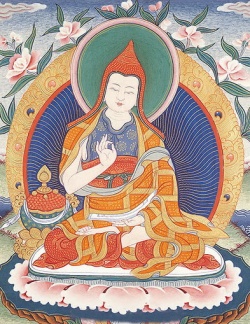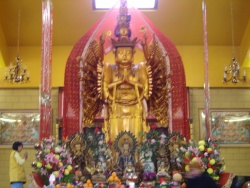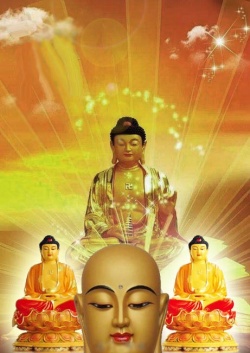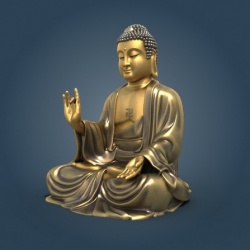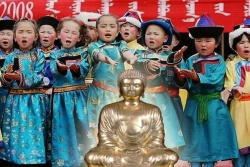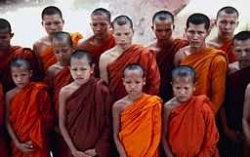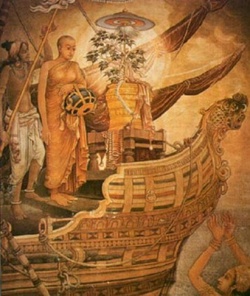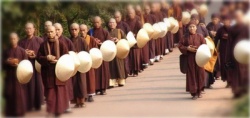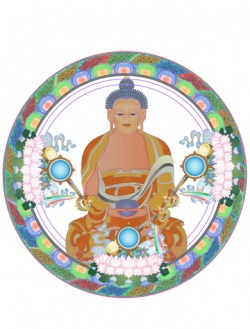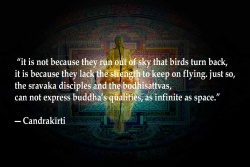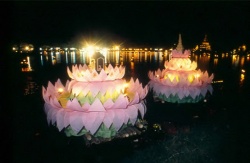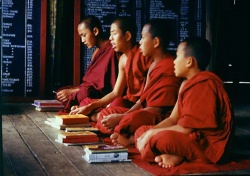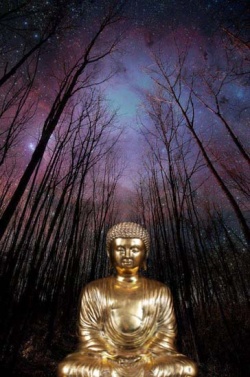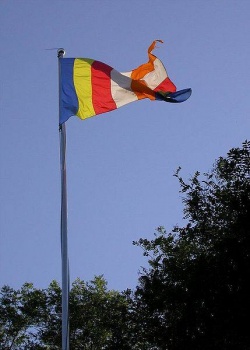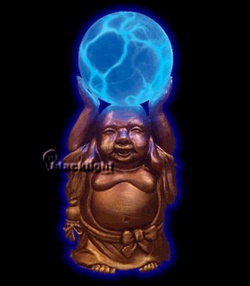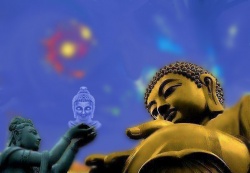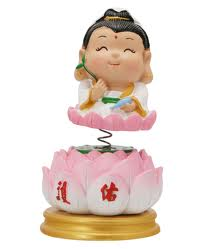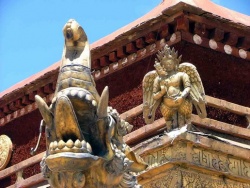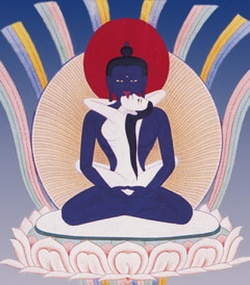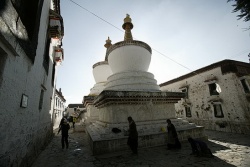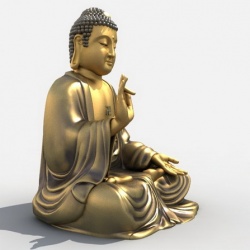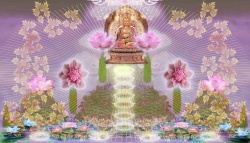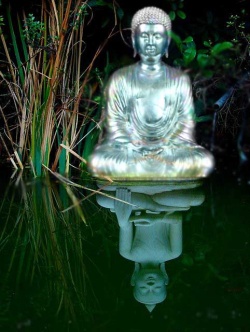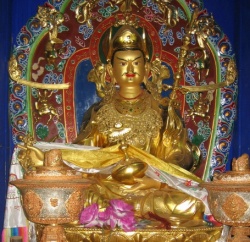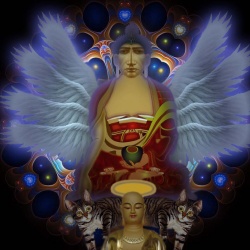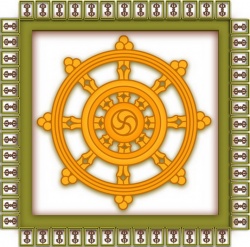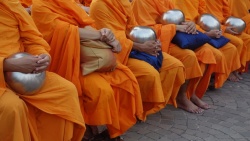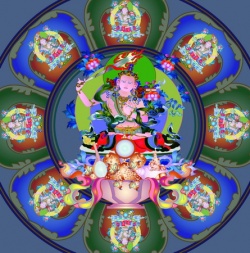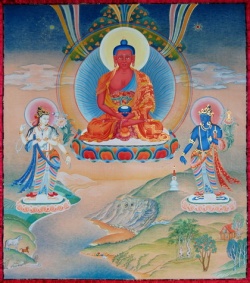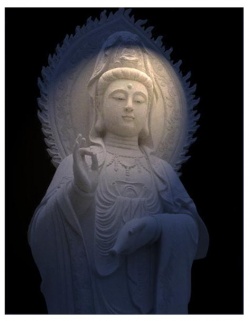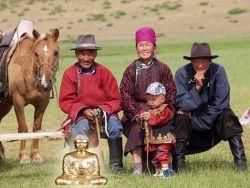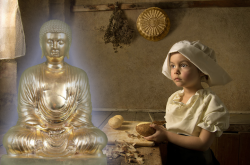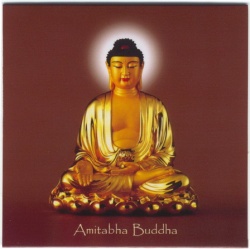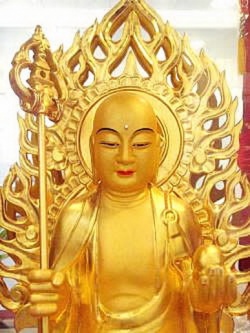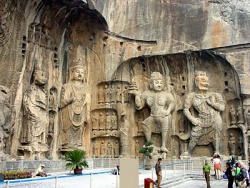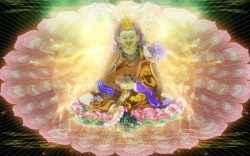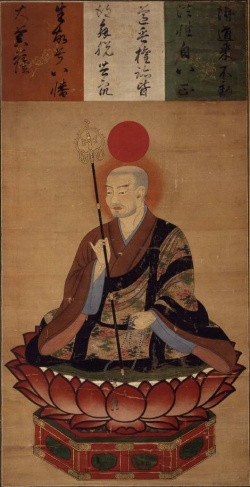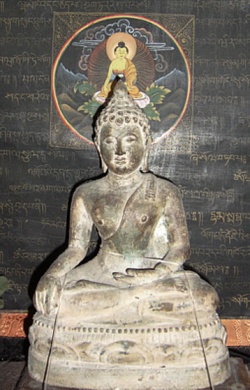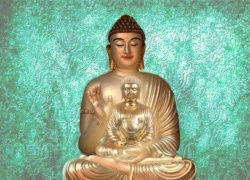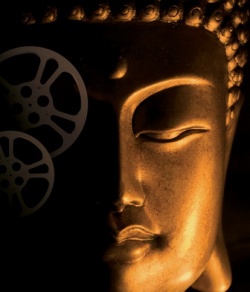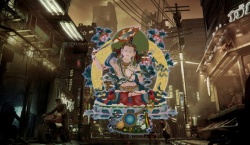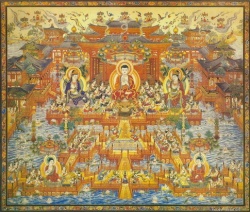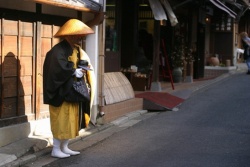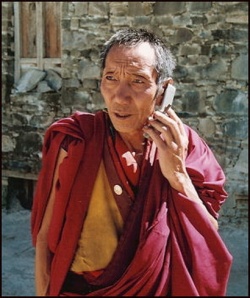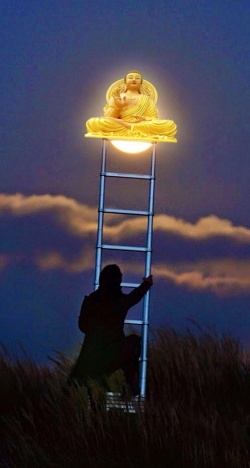On the Buddha-nature of Insentient Things
by Robert H. Sharf
The University of Michigan
On the Buddha-nature of Insentient Things (or: How to Think about a Ch'an Kung-an)
A monk asked Chao-chou:
"Does a dog have buddha-nature or not?"
Chao-chou replied: "He does not."
Wu-men kuan)
I.
Sometime during the seventh and eighth centuries a new doctrine gained currency among Chinese Buddhist exegetes, an doctrine that came to be known as "the buddha-nature of the insentient" (wu-ch'ing fo-hsing Ùíï×ÝÖàõ, hereafter "BNI"). According to this teaching, not only do all sentient beings possess the inherent nature of buddhahood, but so do plants and trees, stones and tiles, and even particles of dust. Of course, stated in this manner, it might appear as simply another expression of the familiar Mahaayaana teaching Jof non-duality: since everything is dependently originated and thus devoid of an abiding essence or "self-nature" (svabhaava), everything is inherently pure, empty, and quiescent. From this perspective, there is no ultimate distinction between the absolute on the one hand (be it styled dharmakaaya, tathataa, nirvaana, ^suunyataa, original mind, buddha, or what have you), and the multifarious world of lived experience on the other.
Nevertheless, the claim that insentient objects possess buddha-nature would have initially sounded odd, if not preposterous, to a medieval Buddhist scholiast. As early critics were quick to point out, the doctrine contravened well-known passages in authoritative Mahaayaana scriptures that explicitly restricted buddha-nature to sentient beings.
Moreover, there were no scriptural precedents for insentient objects actually attaining bodhi;
nor had anyone ever witnessed such an occurrence. In response, proponents of BNI appealed to the doctrines of skillful means (upaaya) and the "division of the teachings" (p'an-chiao ÷÷Îç) to defend their position: they dismissed scriptural passages that contravened their position as provisional teachings for those of limited capacity. While the debate would continue throughout the medieval period, by the Sung Dynasty the BNI doctrine appears to have gained wide acceptance in both T'ien-t'ai and Ch'an circles, and it was embraced by many eminent Japanese monks as well, including the founders of the Shingon, Tendai, S?t?, and Nichiren schools.
The notion that insentient objects--objects that we might consider part of the natural or physical world--possess buddha-nature has attracted the attention of a number of contemporary scholars. For those interested in the issue of "sinification" (a widespread passion among specialists in Chinese Buddhism), the notion is especially intriguing. Scholars have surmised that concern with inherent buddha-nature (fo-hsing ÝÖàõ) gained prominence in China in part due to the indigenous Chinese preoccupation with humankind's hsing àõ or "inherent nature," a philosophical theme that dates back to the Warring States period. This issue was eventually decided in favor of the Mencian view that humankind's nature is inherently good, a position that resonated with the Mahaayaana claim that all beings possess the nature of buddhahood. While the theory of buddha-nature itself can be traced back to Indian sources (it is closely associated with tathaagatagarbha thought),1)
the extension of buddha-nature to the insentient was a distinctively Chinese innovation. It is, in short, a conveniently discrete and perhaps paradigmatic specimen of "sinification." One might then interpret the BNI doctrine as an attempt by Buddhists to appropriate the discourse concerning hsing from the Juists and to trump them at the same time; in contrast to the expansive Mahaayaana vision of universal buddha-nature, extending even to walls and roof-tiles, the Juist discourse on hsing appears relatively mundane and parochial.
The East Asian Buddhist controversy concerning inherent buddha-nature endured through the centuries, and has emerged once again in a recent Japanese debate over what is and what is not "authentically Buddhist." In short, the two Japanese proponents of "critical Buddhism" (hihan bukky? Ýë÷÷ÝÖÎç), Matsumoto Shir? áæÜâÞÈÕÍ and Hakamaya Noriaki ÍÍÍÛúÊá¹, insist that metaphysical absolutes such as "buddha-nature" are not only antithetical to the original teachings of ?aakyamuni, but are also responsible for the moral failings of the Japanese Buddhist priesthood.2) (The dogma that ultimately all distinctions are illusory--that all beings are essentially equal from the perspective of their shared buddha-nature--is inherently reactionary in so far as it obviates the need for genuine equality, social justice, and political engagement.) From the perspective of Matsumoto and Hakamaya's "critical Buddhism," the extension of buddha-nature to insentient objects only exemplifies the exegetical excess, and the intellectual and moral bankruptcy, that is occasioned by the wanton reification of the absolute.
While the BNI doctrine promises to reveal something about what makes Chinese Buddhism Chinese (and perhaps what makes Japanese Buddhism Japanese), this is by no means the sole reason for contemporary interest in the topic. Of equal if not greater significance is the assumption that the doctrine pertains to native Buddhist conceptions of nature and attitudes toward environmental and ecological issues. On the surface, the BNI doctrine appears to both valorize the world of nature, and to affirm our place within, rather than apart from, the material world in which we find ourselves. 3)
This is a now familiar theme; one repeatedly reads that the Chinese and Japanese view themselves as one with nature, in marked contradistinction to Occidentals who position themselves outside the natural world, as its lord and master. This is due, we are told, to very different sets of metaphysical presuppositions resulting from divergent cultural legacies. The Western belief in an ontological rift between the human realm and the world of nature is supposedly tied to Judeo-Christian monotheism, which postulates an enduring divide between the creator and his creation, a divide that is replicated in the later Cartesian bifurcation of the immaterial world of spirit and the physical world of extended matter. In contrast, indigenous East Asian traditions such as Taoism and Shinto do not envisage a gap between the contingent realm of human experience and the realm of truth. Chinese and Japanese religious thought exalts the world of nature as the locus of spiritual insight, freedom, and liberation. The BNI doctrine would seem to be an unambiguous, if metaphorical, expression of this Chinese vision of the "unity of man and nature."
Of course, if it is true that our metaphysical intuitions are constructed by our specific linguistic, intellectual, and cultural legacies, and that the legacy of the "East" is fundamentally different from that of the "West," then it follows that the Chinese may not simply differ from us in their attitude toward nature; rather, their view of the world might not include anything that quite corresponds to our concept of "nature" in the first place. Which makes one wonder: in the absence of a shared epistemic referent--a trans-cultural, trans-linguistic, trans-historical signified to which the signifier "nature" corresponds--is there any sound intellectual basis for such grandiose cross-cultural comparisons? Are efforts at this level of generality necessarily vacuous? Or worse, do they lie in the service of a more nefarious ideological agenda? 4)
I intend to avoid these murky hermeneutic waters below. My own sense is that the early sources pertaining to the buddha-nature of the insentient actually reveal little about native Chinese views of "nature," and have even less to say with respect to contemporary ecological concerns. As we shall see, the sources tend to be implacably scholastic--they are wedded to a gordian doctrinal system that is predicated on the authority of a host of institutionally sanctioned Indian and Chinese texts. The fact that the doctrines espoused by these texts were frequently at odds with each other only fueled the development of increasingly convoluted and abstruse interpretative strategies.
While most scholars will readily acknowledge the scholastic nature of much medieval Buddhist thought, Ch'an is often presented as an exception. Ch'an is viewed as one school that explicitly eschewed scholastic pursuits, in favor of rigorous meditative practice leading to transformative insight. The literary form most distinctive of Ch'an, the kung-an ÍëäÐ("public case"), is accordingly presented as an attempt to foil the discursive impulse that is essential to the scholastic enterprise. But a careful reconstruction of the debate over BNI gives a very different view of Ch'an: not only were Ch'an masters active and passionate participants in this quintessentially discursive controversy, but, as we will see, the BNI doctrine was the immediate context for the most famous kung-an of all, "Chao-chou's dog."
My first task will be to review the early development of the BNI doctrine. As the relevant materials have been the subject of a number of detailed historical and doctrinal studies, my review will be brief. 5) I will, however, pay somewhat more attention to early Ch'an sources than I do to San-lun, Hua-yen, or T'ien-t'ai materials as the Ch'an involvement in the debate has heretofore received relatively little notice in Western studies.
II.
The fifth-century monk Tao-sheng Ô³ßæ(360-434) appears to have been the first to advance the theory that all sentient beings, including icchantika, possess buddha-nature. 6) The claim was contentious in its day, for according to the six-fascicle version of the Nirvaa?a-suutra translated by Fa-hsien and Buddhabhadra, buddha-nature is eternal but icchantika do not possess it. 7) Tao-sheng disagreed, insisting that icchantika too possess the seeds of buddha-nature, and will one day attain buddhahood.
Tao-sheng's position was vindicated with the appearance of Dharmaksema's (385-433 or 436) translation of the sutra in 421. 8) This recension, which became known as the "northern tradition,"9) actually waffles on the topic of the icchantika: the sutra first excludes icchantika from those who possess buddha-nature (T.374: 12.404c4-21); but later it tempers the doctrine, saying that one should direct one's compassion equally to all, including icchantika, with the desire that they may be enlightened (454a6ff., 456a24ff.); that the Buddha preaches to the icchantika because at least some of them possess the faculties necessary for enlightenment (482b3-12); that all icchantika possess buddha nature and thus are capable of attaining enlightenment (493b20 ff.); and that all, including the icchantika, will attain supreme enlightenment once they abandon their original defilements (505c14-15).10)
Dharmaksema's translation of the Nirvaa?a-suutra served as the earliest and most important canonical statement of the universality of buddha-nature in China. However, the text unambiguously restricts the possession of buddha-nature to sentient beings: "'Non-buddha-nature' refers to insentient things such as walls and fences, tiles and stones.
Everything apart from insentient things such as these is called 'buddha-nature.'" ÞªÝÖàõíº á¶êÝìéôîî¡Ûúè¿à´Ùíï×ñýÚª, ×îåýãÀÔõÙíï×ñýÚªãÀÙ£ÝÖàõ.11) This was indeed the prevailing view throughout the Northern and Southern Dynasties, a period in which the Nirvaa?a-suutra played a prominent role in scholastic exegesis, and served as the subject of numerous commentaries.12)
The developments that would lay the ground for the BNI position did not begin until over a century after the authoritative translations of the Nirvaa?a-suutra gained currency. This development is usually traced to the six-century monk Ching-ying Hui-yüan ïäç¯û´êÀ(523-592), a Ti-lun exegete interested in the relationship between the buddha-nature of the Nirvaa?a-suutra, and "originally pure mind." In his Ta-ch'eng i-chang, ÓÞã«ëùíñ Hui-yüan makes a pivotal distinction between the "buddha-nature that knows" Òöò±àõ, and the "buddha-nature that is known" á¶ò±àõ(T.1851: 44.472c). The former is described as the "mind of true consciousness" òØãÛãý that is capable of awakening to buddha-nature through the elimination of ignorance. The text explains that "this nature is situated in sentient beings, and does not extend to the insentient" ÏÑî¤ñëßæ ÝÕ÷×Þªï× (472c18-19). Thus when the Nirvaa?a-suutra says that buddha-nature is present only in sentient beings, it is referring to the "buddha-nature that knows." The latter, the "nature that is known, is like the dharma-nature, the apex of reality, the mark of reality, the dharma-realm, the supreme meaning of the teachings and the sutras which is emptiness, ultimate truth, and so on" á¶ò±àõíº êÝåýÛöàõãùð·ãùßÓÛöÍ£ÛöÌèð¯ìéëùÍöìéãùôôÔõ (472c22-23). When the scriptures call the highest teaching "buddha-nature," or when they call the middle-way "buddha-nature," they are referring to the "nature that is known." Hui-yüan explicitly says that this aspect of buddha-nature penetrates everywhere, both within and without (472c25-26), the implication being that it extends to insentient as well as to sentient things.
Hui-yüan's bifurcation of buddha-nature is in some respects structurally analogous to our distinction between epistemology and ontology, in so far as it distinguishes between buddha-nature as the "content" of a rarefied and non-dualistic mode of cognition, and buddha-nature as the ground of being that makes such a cognition possible. This conceptual structure will find its way into much of the subsequent theorizing on the subject.
While Hui-yüan has all the pieces in place, he never actually states that insentient objects possess buddha-nature. The first to do so appears to have been the San-lun commentator Chi-tsang ÑÎíú (549-623). Chi-tsang takes a somewhat different approach to the issue than does Hui-yüan: rather than beginning with a bifurcation of buddha-nature into two aspects, one of which is coterminous with the insentient and one of which is not, Chi-tsang argues that the distinction between sentient and insentient is itself ultimately empty.13)
Thus if you are going to deny buddha-nature to something, then not only are grass and trees devoid of buddha-nature, but living beings are also devoid of buddha-nature. But if you hold to the existence of buddha-nature, then it is not only living beings that have buddha-nature, but grass and trees must also have buddha-nature.... Since there is no duality between the dependent and the true, if sentient beings possess buddha-nature, grass and trees must also possess buddha-nature. For this reason we maintain that it is not only sentient beings that possess buddha-nature, but grass and trees also possess buddha-nature. If we understand that all dharmas are equal and do not view the two marks of the dependent and the true, then in reality there are no marks of attainment or non-attainment. Since there is no non-attainment, we provisionally speak of attaining buddhahood. Thus at the moment when sentient beings attain buddhahood, all grass and trees also attain buddhahood.14)
For Chi-tsang, the rubric of buddha-nature is merely another way of affirming emptiness, dependent origination, and the middle way, from which vantage point all distinctions, including that between sentient and insentient, must be relinquished. Buddha-nature is not a something that could be possessed by, or reside in, sentient, much less insentient, things.
Nonetheless, Chi-tsang immediately goes on to qualify his thesis, conceding that his analysis proceeds from the perspective of "pervasiveness" ÷×Ú¦, wherein all distinctions fall away. From the perspective of "difference" ܬڦ, however, one can indeed distinguish between sentient and insentient:
Because sentient beings have mental delusions, they can attain the truth of awakening. Grass and trees have no mind, and thus they have no delusion. What would it mean for them to obtain awakening? It is like waking from a dream: if you are not dreaming, then you cannot waken from it. Therefore it is said [in the Nirvaa?a-suutra] that since sentient beings possess buddha-nature they can attain buddhahood, but since grass and trees are devoid of buddha-nature they cannot attain buddhahood.15)
Thus while Chi-tsang is willing to come out and declare, perhaps for the first time, that insentient objects possess buddha-nature, he attempts to stay within the confines of the Nirvaa?a-suutra teachings, and readily concedes that the attainment of enlightenment is only possible for sentient beings. 16)
Both Hui-yüan and Chi-tsang were primarily interested in emphasizing, in the scholastic idiom of their day, the message of the universality of the buddha-nature. They had no choice but to deal with the sentient/insentient distinction, as it occurs in the very passage of the Nirvaanaa-suutra that served as the locus classicus for the doctrine. On the whole, one gets the impression that the sentient/insentient issue was somewhat inconsequential to their larger projects, and it is difficult to imagine what practical ramifications might have been entailed in one's defense or rejection of the BNI thesis.
By the early T'ang the doctrine of universal buddha-nature, or the ultimate identity of the buddha and all beings, had become a hallmark of orthodoxy among many Chinese Buddhist commentators. The idea appears in diverse formulations, many of which simply fudge the distinction between sentient and insentient. Typical is the following passage in the apocryphal, but highly influential, Yüan-chüeh ching êÊÆÌè, likely composed in China sometime during the second half of the seventh century.
Wisdom and foolishness interfuse as praj~naa. The teachings accomplished by both bodhisattvas and heretics are equally bodhi. The realms of ignorance and true suchness are not different. Morality, meditation, wisdom, and greed, anger, and delusion are all noble practices. All the worlds of sentient beings share the same dharma-nature; the hells and the heavens are all pure lands. Those with and those without (buddha-]nature all attain the buddha way. The defilements are all ultimate liberation. The dharmadhaatu's ocean of wisdom illuminates all phenomena as if it were empty space.
òªû´é×öÂ÷×êÓÚõå®. ÜÌß±èâÔ³á¶à÷ö¦Ûö ÔÒãÀÜÌð«. ÙíÙ¥òØåýÙíì¶ÌÑÍ£. ð³ÌüïÒû´ÐàêýÒÁöÂÎüãÀÛïú¼. ñëßæÏÐ÷ÏÔÒìéÛöàõ. ò¢è«ô¸ÏàËËêÓïä÷Ï. êóàõÙíàõðºà÷ÝÖÔ³. ìéôîÛáÒÝù´Ìåú°÷. ÛöÍ£úû´ðÎÖõð³ßÓë¢åýúÈÍö.
(T. 842: 17.917b3-8)
I suspect that the figurative claim that all beings are destined for buddhahood, irrespective of their possession of buddha-nature, was intended to subsume the category of the insentient along with the sentient, without saying so explicitly. (To do so might have raised suspicions concerning the provenance of the scripture.) 17) The exegetical challenge of the day was to be as conceptually inclusive and comprehensive as possible.
But the urge toward increasingly comprehensive and expansive rhetorical formulations would inevitably run up against the scripturally sanctioned dichotomy between the sentient and the insentient. Exegetes were thus forced to reproduce the hermeneutic strategies pioneered by Hui-yüan and Chi-tsang. Witness, for example, the manner in which the Hua-yen exegete Fa-tsang (643-712) handles the issue: in a discussion of the meaning of "dharma-nature" (fa-hsing Ûöàõ) in the Ta-ch'eng ch'i hsin lun i-chi ÓÞã«ÑÃãáÖåëùÑÀ, Fa-tsang explains that "true suchness òØåý pervades both the defiled and the pure, the sentient and the insentient." Citing an unnamed treatise he goes on to say that, with regard to sentient beings, suchness is called buddha-nature, and with regard to non-sentient beings it is called dharma-nature. 18) He makes much the same point in his Hua-yen ching t'an hsüan chi ü¤åñÌè÷®úÜÑÀ, where he writes that "while the nature of true suchness taught by the three vehicles permeates both the sentient and the insentient, only sentient beings can awakening to buddha-nature." 19) Fa-tsang, much like Hui-yüan, appeals to a distinction between epistemology and ontology in order to assert the buddha-nature of the insentient without contravening the letter of the Nirvaanaa-suutra. And Chi-tsang's distinction between the absolute and the contingent (the non-dualistic perspective of the absolute versus the perspective of contingent experience), amounts to much the same thing. In all three cases there is a reluctance to challenge scriptural authority.
The full development of the doctrine that insentient things have buddha-nature is usually associated with the T'ien-t'ai school, particularly with the work of Chan-jan ÓÀæÔ (711-782). We will see below that this is somewhat misleading: Chan-jan was likely following the lead of certain prominent Ch'an masters of his day. Be that as it may, Chan-jan is the first on record to directly challenge the authority of the Nirvaanaa-suutra on the issue.
As the self-conscious architect of T'ien-t'ai orthodoxy, Chan-jan denies the originality of his position, claiming to find precedent in the Mo-ho chih-kuan ؤʸòκ. Specifically, Chan-jan refers to a passage from Kuan-ting's δð¢ (561-632) preface to the work that was considered by the later tradition to represent the very essence of T'ien-t'ai teaching. 20) Speaking of the "perfect and sudden" êÔË practice Kuan-ting writes: "When [the mind) is fixed on the dharma-realm--when [each] moment of thought [is one with] the dharma-realm--then there is not a single form nor a single smell that is not the middle way" ͨæÞÛöÍ£ ìéÒ·ÛöÍ£ ìéßäìéúÅ ÙíÞªñéÔ³ (T.1911: 46.1c24-25). In his Chih-kuan fu-hsing ch'uan hung chüeh, òκÜÐú¼îîûð̽, Chan-jan explains that this reference to the single form and the single smell refers to the universality of buddha-nature, even among insentient things:
Based on the principle of identity [the Mo-ho chih kuan) here says that "each and every color and scent is the middle way." "Colors" and "scents" are unanimously considered insentient. However, to accept that color and scent is the middle way [is to accept that] insentient things [possess] buddha-nature. [This] jars the ear and boggles the mind.21)
In fact, neither Chih-i nor Kuan-ting explicitly countenance the buddha-nature of the insentient. On the contrary, in his commentary on the Nirvaanaa-suutra, Kuan-ting unambiguously states that insentient beings do not possess buddha nature: "While there is buddha-nature in sentient beings, there is no buddha-nature in grass and trees; rather, they have the nature of grass, trees, etc." 22) In order to bring his own doctrine into line with the writings of his predecessors, Chan-jan plays the upaaya card: he insists that Kuan-ting fully understood the buddha-nature of the insentient, but that he hesitated to say so as the times were not yet fitting.
But there is evidence that Chan-jan did recognize the novelty of his own position, at least within the T'ien-t'ai fold. The tacit acknowledgment is found in the opening of his Chin-kang pei ÐÝ˧?, a short work written around 780, not long before his death, that is devoted exclusively to the defense and clarification of the BNI doctrine.23) The text opens with an autobiographical statement of how the text came into being: it seems that one quiet night Chan-jan found himself contemplating the sublime and interwoven T'ien-t'ai teachings concerning the centrality of buddha-nature, the unity of all oppositions, the existence of all realms in a single instant of thought, and so on. Chan-jan reports that in the midst of his reverie he "fell into a trance-induced sleep. From my subconscious, I proclaimed 'insentient things possess (buddha-]nature.'" 24) The rest of the text is presented as a transcript of the ensuing conversation with interlocutors that appear in his dream. The treatise closes abruptly with the following: "I suddenly awoke from my dream. The questioner, the respondent, the questions and answers, all were ungraspable."25)
This would seem to be a remarkable admission: on the one hand Chan-jan presents his position on BNI as emerging from reflection on cardinal T'ien-t'ai principles. On the other hand, the fact that the doctrine occurs to him in the midst of an inspired dream would seem to concede the originality of his thought.
The thrust of Chan-jan's position is quite simple: Mahaayaana doctrine (1) insists on the universality of buddha-nature, and (2) will not ultimately brook a distinction between sentient and insentient things:
The individual of the perfect (teaching) knows, from beginning to end, that the absolute principle is non-dual, and that there are no objects apart from mind. Who then is sentient? What then is insentient? Within the Assembly of the Lotus there is no discrimination. What difference is there between the [three types of medicinal] herbs and the [two types of] trees, and the soil [in which they grow], or between the four elements [of which they are comprised]?
êìÑã·ØÇò±×âÝÕì£ ãýèâÙíÌÑâÁï×Ùíï× Ûöü¤üåñé ìéôîÝÕÌ° õ®ÙÊæ¨ò¢ÞÌÚ°ù¼â¨.26)
According to Chan-jan, statements to the contrary, such as the notorious passage in the Nirvaanaa-suutra denying buddha-nature to the insentient, must be understood as pratipak?a--they are intended as expedient antidotes to particular misconceptions and thus must not be taken at face value.27)
Chan-jan's approach to the BNI doctrine shows the influence of his predecessors: his willingness to invoke absolutes such as "principle" or "mind" recalls the Ti-lun exegesis advanced by Hui-yüan, while his critique of the sentient-insentient dichotomy is reminiscent of Chi-tsang. But there are differences: first, Chan-jan is willing to dismiss certain passages in the Nirvaanaa-suutra as expedient or provisional teachings. Second, there is Chan-jan's use of the imagery of the Lotus assembly, which seems to move the discussion away from the somewhat arid abstractions of earlier Nirvaanaa-suutra commentators, to a more poetic vision of the phenomenal world as the very locus of awakening. In other words, for Chan-jan, to claim that the insentient possess buddha-nature is not merely to grant inanimate objects an inherent potential that will never be realized; nor is it a purely metaphysical theory predicated on the perspective of absolute truth. Rather, Chan-jan seems to be saying that the very colors and smells of the world around us constitute the Assembly of the Lotus; they are the immediate and undefiled expression of buddhahood.
Chan-jan was the first to devote an entire treatise to the defense of BNI. The fact that the Chin-kang pei was the only treatise he ever wrote (the remainder of his corpus consists largely of commentaries), and that it was written near the end of his life, suggests that the doctrine was of particular significance to him. Why would he have devoted so much energy to this single and somewhat idiosyncratic scholastic concern? While the available sources may be insufficient to provide a definitive answer, there is evidence that the BNI doctrine had emerged as a pressing and controversial issue in eighth-century Buddhist circles. It seems that the immediate pretext for Chan-jan's work was not the scholastic arguments advanced by earlier generations of Ti-lun, San-lun, and Hua-yen commentators, so much as the unorthodox positions touted by certain of Chan-jan's contemporaries, contemporaries associated with the nascent Ch'an tradition.
III.
The Leng-ch'ieh shih-tzu chi ×ÑÊ¡ÞÔíÀÑÀ, a text recovered from Tun-huang and associated with the "Northern-school" of Ch'an, is attributed to Ching-chueh ïäÊÆ (683-ca. 750), and is believed to date from the early part of the Kai-yuan period (713-742).28) The issue of the buddha-nature of the insentient is first mentioned in the record of the fourth-patriarch Tao-hsin Ô³ãá (580-651): "The Nirvaanaa-suutra says: 'All beings have buddha-nature.' If you say that walls, fences, tiles, and stones do not have buddha-nature, then how could they preach the dharma?"29) And in the biography of the fifth-patriarch Hung-jen ûðìÛ (601-674) that immediately follows we find the following:
(Hung-jen) said: "The Buddha has thirty-two marks. Do jars also have the thirty-two marks or not? Do pillars have the thirty-two marks or not? Proceeding in the same way we ask if earth, trees, tiles and stones have the thirty-two marks or not?"... He also said: "At the moment when you are in the temple sitting in meditation, is your body also sitting in meditation beneath the trees of the mountain forests or not? Are earth, trees, tiles, and stones also able to sit in meditation or not? Are earth, trees, tiles, and stones able to see forms and hear sounds, wear a robe and carry a bowl, or not? When the La?kaavataara-suutra speaks of the dharma-body of the realm of objects ÌÑÍ£Ûöãó, it [refers to] just this.30)
Both Tao-hsin and Hung-jen allude to the non-duality of the subjective and objective worlds, as well as to the doctrine that "all is mind" that is closely associated with the La?kaavataara. This appears to lead to their inference that even the inanimate objects of our perception possess buddha-nature and "preach the dharma."
It is impossible to know whether this accurately depicts the teachings of either Tao-hsin or Hung-jen, or whether it rather represents the thought of the editor (or editors) of the Leng-ch'ieh shih-tzu chi. As we will see below, other texts, notably the Platform Sutra, depict Hung-jen as rejecting rather than espousing the BNI position. Nonetheless, the passages attest to an interest in the issue among Ch'an teachers in the early part of the eighth century, just as Chan-jan was beginning his career.
The Leng-ch'ieh shih-tzu chi is not an isolated example. The Chüeh-kuan lun ï¾ÎºÖå, or "Treatise on the Extinction of Contemplation," is a short text associated with the Ox-head lineage (Niu-t'ou tsung éÚÔéðó), six manuscript copies of which were recovered from Tun-huang. While the text has been attributed to Bodhidharma, Ho-tse Shen-hui ùÃ÷Êãêüå (684-758), and Niu-t'ou Fa-jung éÚÔéÛöë× (594-657), among others, it was likely composed by a later Ox-head teacher sometime during the third quarter of the eighth century, i.e., just around the time that Chan-jan was formulating his own position on BNI.31)
The text takes the form of a conversation between a teacher, named "Attainment" (ju-li ìý×â), and his disciple "Gateway" (yüan-men æÞÚ¦). About a third of the way into the text we find the following exchange:
Gateway asks, "Is the Way found only in embodied spiritual entities, or does it reside in grass and trees as well?" Attainment says, "There is no place the Way does not pervade." [Gateway] asks, "If the Way is pervasive, why is it a crime to kill a man, whereas it is not a crime to kill grass and trees?" (Attainment) answered, "Talk of whether it is a crime or not is a matter related to sentience, and is thus not the true Way. It is only because worldly people have not attained the truth of the Way, and falsely believe in a personal self, that their murder entails mental [intent]. This intent bears karmic fruit, and thus we speak of it as a crime. Grass and trees have no sentience, and are thus originally in accord with the Way. As they are free of a self, there is no calculation involved in killing them, and thus we do not argue over whether it is a crime or not.
Now one who is free of a self and is in accord with the Way looks at his own body as he would at grass or at trees. He bears the cutting of his own body as do trees in a forest. Therefore, when Ma~nju^sr? held a sword toward Gautama (Buddha), or when Angulimalya held out a knife at ?aakyamuni, they were both in accord with the Way.32) Both realized non-origination, and completely comprehended the emptiness and nonexistence of illusory transformations. That is why we do not argue about whether it was a crime or not."
[Gateway] asks, "If grass and trees have long been in accord with the Way, why do the sutras not record instances of grass or trees becoming buddhas, but only of persons [becoming buddhas)?" (Attainment) answers, "They do not only record persons, but record grass and trees [becoming buddhas) as well. A sutra says, 'A single mote of dust contains all dharmas.' Another says, 'All dharmas are suchness; all sentient beings are also suchness.'33) Suchness is devoid of any duality or discrimination."
æÞÚ¦ÙýèØ, Ô³íºêÓÔ¼î¤åÚû¡ÖÄñýñéå, æ²î¤åÚõ®ÙÊñýñéå. ìý×âèØ, Ô³Ùíá¶ÝÕø¼å¥. ÙýèØ, Ô³å´ø¼íº, ù¼Íºß°ìÑêóñª, ß°õ®ÙÊÙíñª. ÓÍèØ, ÜýåëñªÝÕñª, ËËãÀö¦ï×å³ÞÀ, ÞªïáÔ³å¥. Ó£êÓá¦ìÑÜôÓ¹Ô³×â, ØÍØ¡ä²ãó, ß°ñíêóãý, ãýÌ¿åÚåö, ñíéöñªå¥. õ®ÙÊÙíï×, ÜâÕÎùêÔ³, ×âÙíä²Íº, ß°íºÝÕͪ, ñíÝÕÖåñªæ¨Þªñª, ÜýÙíä²ùêÔ³íº, ãÊû¡åýõ®ÙÊ, ù¬íÅåýâ§×ù. ͺÙþâ¨òûËýåÚϺӾ, äìÏÞò¥ÓïåÚà·ä«. ó®ËËùêÔ³, ÔÒñûÝÕßæ, Öõò±ü³ûùúÈÙí. ͺñíÜôÖåñªæ¨Þªñª. ÙýèØ, õ®ÙÊÎùÕÎùêÔ³, Ìèñéù¼ÍºÝÕÑÀõ®ÙÊà÷ÝÖ, ø¶ÑÀìÑå¥. ÓÍèØ, ÞªÔ¼ÑÀìÑ, æ²ÑÀõ®ÙÊ. Ìèéö, åÚìéÚ°òÈñé, ÎýùßìéôîÛö. éÑéö, ìéôîÛöæ²åýå¥, ìéôîñëßææ²åýå¥. åýÙíì£Ùíó¬Ü¬.34)
This work represents a significant departure from the arguments advanced by the San-lun, Hua-yen, and T'ien-t'ai authors mentioned above. On the one hand, the Chüeh-kuan lun accepts that, from a worldly perspective, grass and trees are indeed insentient. But precisely because they lack mind and sentience, and thus have no thought of "me" or "mine," grass and trees are "in accord with the Way." The treatise goes so far as to claim scriptural support for the view that insentient things actually become buddhas (ch'eng fo). The way to buddhahood is the way of insentience: one must put an end to discernment (chüeh-kuan ï¾Îº) and become mindless (wu-hsin Ùíãý). Then, like the grass and trees, you will be one with the Way, and utterly unconcerned with death.
The BNI doctrine also finds support in the Pao-tsang lun ÛöíúÖå, a text traditionally attributed to Seng-chao ã¬ðÜ (374-414), but which is believed to date to the late eighth century.35) This text is loosely associated with early Ch'an in general, and the Ox-head line in particular, a finding that is consistent with the brief passage on BNI in chapter three:
The scripture says: "Buddha-nature is uniform, expansive, and difficult to fathom." There is no duality between an ordinary person and a sage: (buddha-nature) fills everything, wholly suffusing the grass and trees, fully pervading the ants, reaching even to the tiniest mote of dust, and the very tip of a strand of hair--there is nothing that exists and yet does not embody the One. ùàÝáõ®ÙÊñ²ø¼äÝëü Ò¬ò¸Ú°òÈپۥذÝÕùßìéì»êó.36)
The rare mention of "ants" in conjunction with the BNI thesis is significant, as it likely alludes to a passage from the Chuang-tzu that may have been influential in the development of this doctrine (see below).
A similar pro-BNI position is also attributed to the Northern Ch'an master Shen-hsiu ãêâ³ (605?-706) in the Tsung-ching lu ðóÌðÖâ, a text compiled by Yen-shou çµÙ¥æÅáø (904-975) and published in 961. Shen-hsiu teaches that "when sentient beings cultivate realization, insentient beings also cultivate realization." ñíêóï×áóñû ãÀÞªï×áóñû. There is ultimately no distinction between self and other, or consciousness and its objects.37) While the Tsung-ching lu is relatively late and thus unreliable as a window on Shen-hsiu's original teachings, it is nevertheless significant that Yen-shou's sources associated this venerable "Northern Ch'an" figure with the BNI doctrine.
This admittedly fragmentary evidence suggests an interest among some early Ch'an teachers in a somewhat radical version of the BNI doctrine. These texts depict the BNI not merely as a universal metaphysical ground, nor do they reduce the argument to the non-duality of the sentient and the insentient. Rather, these Northern Ch'an texts all suggest that insentient objects actually "cultivate realization" and "become buddhas."
However, not all of the early Ch'an leaders agreed: some prominent figures found the BNI position utterly untenable. One of the more strident rejections of the BNI doctrine is found in the record of Shen-hui, in which he debates an Ox-head opponent on the subject:
Ch'an Master Yuan of Ox-Head Mountain asked: "[You say that] buddha-nature permeates all sentient things, and does not permeate all insentient things. I heard a venerable elder say:
Lush groves of emerald bamboos,
Are wholly the dharma-body.
Luxuriant clusters of chrysanthemums,
Nothing is not praj~naa.
ôìôìö¨ñÓ ò×ãÀÛöãó ê¦ê¦üÜùÁ ÙéÞªÚõå®38)
Now why do you say that (buddha-nature) only permeates sentient things, and does not permeate insentient things?" (Shen-hui) answered: "Surely you do not mean that the merit of lush groves of emerald bamboos equals that of the dharma-body, or that the wisdom of luxuriant clusters of chrysanthemums is the same as praj~naa? If the groves of bamboos and chrysanthemums are equal to the dharma-body and to praj~naa, then in which sutra does the Tathagata record a case of an emerald bamboo or a chrysanthemum attaining bodhi? The notion that emerald bamboos and chrysanthemums are the same as the dharma-body and praj~naa is a heterodox doctrine. Why so? Because the Nirvaanaa-suutra says: 'That which lacks buddha-nature is deemed an insentient thing.'"39)
This exchange, as well as others to be discussed below, attest to the controversial status of the BNI thesis in the mid-eighth century. Moreover, there is reason to believe that Shen-hui and his followers flagged the BNI thesis as a means to distinguish themselves from their Northern Ch'an rivals: while the Leng-ch'ieh shih-tzu chi depicts the fifth-patriarch Hung-jen as a supporter of BNI, the Platform Sutra has Hung-jen espousing the very opposite. In a list of "transmission verses" near the end of the Tun-huang version of the text, Hung-jen's verse is given as follows:
Sentient beings come and lay down seeds,
And insentient flowers grow.
Without sentiency and without seeds,
The ground of mind produces nothing.
êóï×ÕÎù»ðú, Ùíï×ü£ñíßæ. Ùíï×éÑÙíðú, ãýò¢æ²Ùíßæ.40)
The doctrinal purport of the verse is not as clear as it might be, and it is not surprising that later versions of the verse found in the Tsu-t'ang chi ðÓÓÑó¢,41) the Ching-te ch'uan-teng lu ÌØÓìîîÔóÖâ,42) and the "vulgate" edition of the Platform Sutra published in 1291,43) modify the wording in such as way as to highlight Hung-jen's opposition to BNI:
Sentient beings come and lay down seeds,
From the earth fruit is produced.
Without sentiency and without seeds,
There is no (buddha-]nature and nothing is produced.
êóï×ÕÎù»ðú, ì×ò¢Íýü½ßæ. Ùíï×ñíÙíðú, Ùíàõæ²Ùíßæ.
Not only is the wording altered, but in the later texts the verse has been incorporated into Hui-neng's autobiographical narrative: the verse figures in the secret transmission ceremony in which Hui-neng receives the dharma. A transmission verse presumably exemplified the very essence of a master's wisdom, as well as his distinctive "teaching style" (feng ù¦). It is thus significant that Hung-jen's verse is a refutation of the BNI thesis. Shen-hui and his followers evidently saw the BNI doctrine as a "wedge issue" with which to distinguish themselves from their Northern rivals; in the process they depicted Hung-jen as espousing precisely the opposite position to that ascribed to him in the Leng-ch'ieh shih-tzu chi.
As the Southern school gained ascendancy in the mid-T'ang other masters would reiterate Shen-hui's opposition to BNI, including Ta-chu Hui-hai ÓÞñÁû´ú (d.u.), a disciple of Ma-tsu Tao-i Ø©ðÓÔ³ìé (709-788). Hui-hai is the purported author of the Tun-wu ju-tao yao-men lun ÔËçöìýÔ³é©Ú¦Öå, a text that addresses the BNI issue at some length.44) The second fascicle of the Tun-wu yao-men contains the following three exchanges on the issue:
Deluded people do not know that the dharma-body has no appearance, but manifests form in response to things. Thus they say that, "Lush groves of emerald bamboos are wholly the dharma-body; luxuriant clusters of chrysanthemums, nothing is not praj~naa." But if chrysanthemums were praj~naa, praj~naa would be the same as the insentient, and if emerald bamboos were the dharma-body, then the dharma-body would be the same as grass and trees. Then when people munch on bamboo shoots, they must be munching on the dharma-body...
Master Chih, a lecturer on the Hua-yen scripture, asked: "Why do you not agree with the aphorism: 'Lush groves of emerald bamboos are wholly the dharma-body; luxuriant clusters of chrysanthemums, nothing is not praj~naa'"? The Master said: "The dharma-body is devoid of appearance, but takes form in response to emerald bamboos. Praj~naa is without knowing, but manifests in response to chrysanthemums. It is not that those chrysanthemums or emerald bamboos themselves possess praj~naa or the dharma-body. Therefore a scripture says: 'The true dharma-body of the buddha is like empty space; it assumes form in response to things, like the moon reflected on water.'"...
A master who lectured on the Hua-yen scripture asked: "Does the Ch'an Master believe that insentient things are the buddha or not?" The Master said: "I don't believe it. For if insentient things were the buddha, then living people would be inferior to the dead. Even dead donkeys and dead dogs would be superior to a living person. A scripture says: 'The buddha-body is precisely the dharma-body; it is born of the precepts, meditation, and wisdom; it is born from the three wisdoms and the six supernormal powers; it is born from all the excellent dharmas.' If you claim that insentient things are the buddha, then were you, venerable one, to die right now, you would make a buddha."45)
Note that Hui-hai is responding to the same aphorism that appears in Shen-hui's work, and advances somewhat similar arguments to dismiss the BNI doctrine as simply absurd.
Huang-po Hsi-yüan üÜÛüýñê¡ (d. ca. 850) is another influential figure who, while he does not directly address the BNI issue, seems to limit buddha-nature to the sentient. In his record we read:
The Master ascended the hall and said: "This very mind is buddha. It reaches upward to all the buddhas, and downwards to things that slither on the ground; everything that contains spirit possesses buddha-nature, and is equal with respect to the substance of the one mind. The reason that Bodhidharma came from India was only to transmit the dharma of one mind, and to directly point to the fact that all beings are originally buddha." ËËêóÝÖàõÔÒìéãýô÷. á¶ì¤Ó¹Ø¤ðôà¤ô¸ÕÎêæîîìéãýÛöòÁò¦ìéôîñëßæÜâÕÎãÀÝÖ.46)
Huang-po's logic, stripped to the bone, is simple: since buddha is mind, only things that possess mind are buddha. Ironically, the identification of buddha and mind is the center of the most eloquent and influential statement in support of BNI, that by the Ch'an master Nan-yang Hui-chung ÑõåÕû´õ÷ (675-775).
Hui-chung, a contemporary of Shen-hui, is credited by the later Ch'an tradition with the teaching that insentient things not only possess buddha-nature, but actually "preach the dharma." Ùíï×àãÛö.47) We have already seen that, according to the Leng-ch'ieh shih-tzu chi, the fourth patriarch beat him to it by a century or so. Nevertheless, Hui-chung's position on the subject is perhaps the most developed in the history of the debate, and I will, accordingly, quote at length from his long disquisition on the topic:
A Ch'an student asked: "What is the meaning of the saying 'the mind of an old buddha.'" The Master said: "Insentient things such as walls, fences, tiles, and stones are all the mind of an old buddha." The Ch'an student said: "But this is at odds with the scriptures. The Nirvaanaa-suutra says: 'Everything apart from insentient things such as walls, fences, tiles and stones is called buddha-nature.' Now you say that all insentient things are the mind of buddha, but you have yet to consider the relationship between 'mind' and 'nature.' Are they different or not?" The Master said, "To the deluded they are different; to the enlightened they are not different." The Ch'an student said, "But this also contradicts the scriptures. It is said in a scripture: 'Good son, mind is not buddha-nature. Buddha-nature is eternal, while mind is not eternal.' Now you say that they are not different. How do you intend to explain yourself?" The Master said: "You rely on the words, rather than on the meaning. It is like a cold winter night, when water is bound up as ice. When warm weather comes, the ice melts back into water. When sentient beings are deluded, their nature is bound up as mind, but when they become enlightened, their minds are released again as (buddha-]nature. If you still maintain that insentient things are without buddha nature, then the scriptures ought not to say that the triple realm is only mind, and that the myriad dharmas are only consciousness. Therefore the Hua-yen suutra says that all the dharmas of the triple realm are produced by mind. Now I ask you, do insentient things exist within the triple realm, or do they exist outside the triple realm? Are they mind, or are they not mind? If they are not mind, the scriptures ought not to say that the triple realm is only mind. If they are mind, [the scriptures) ought not to say that insentient things lack buddha-nature. It is you who contravene the scriptures, not I."
The Ch'an student asked: "If the insentient actually possess mind, can they preach the dharma or not?" The Master said: "They preach magnificently, they preach continually, and they preach eternally without a moment's pause." The Chan student asked: "Then why is it that I do not hear it?" The Master said: "Just because you yourself do not hear it, it does not mean that others do not hear it." [The Ch'an student) continued: "Then who can hear it?" The Master said: "All the sages hear it."...48)
The student asked: "Within the teachings of the scriptures one only sees sentient beings receiving the prophecy of future perfect enlightenment, and then, at some future time, becoming a buddha named so-and-so. One never sees an insentient being receiving the prophecy of future perfect enlightenment and becoming a buddha. Among the thousand buddhas of the current Bhadra kalpa, if there is a single case of an insentient object becoming buddha, please show it to me." The Master said: "I now ask you, imagine a prince at the time of his coronation as king. Does the person of the prince receive the kingship [all at once], or must every territory in the kingdom be individually bestowed upon him?" [The student) replied: "When the prince is crowned king, everything in the kingdom becomes his. What need is there for him to receive anything else?" The Master said: "The present case is just the same: at the moment when sentient beings receive the prophecy of their future buddhahood, all the lands of the three-thousand great-thousand worlds are completely subsumed within the body of Vairocana Buddha. Beyond the body of the buddha, could there still be some insentient object to receive the prophecy?"49) . . .
[The student) asked: "A venerable elder has said:
Lush groves of emerald bamboos,
Are wholly suchness.
Luxuriant clusters of chrysanthemums,
Nothing is not praj~naa.
ôìôìö¨ñÓ ò×ãÀòØåý ê¦ê¦üÜü£ ÙíÞªÚõå®
Some people do not accept this teaching, while others believe in it. The words are inconceivable, and I do not know what to make of it." The Master said: "This pertains to the realms of great beings such as Samantabhadra and Manjusri; it is not something that lesser men are able to believe and accept. This teaching is fully in accord with the intent of the superlative scriptures of the Mahaayaana. Thus the Hua-yen suutra says: 'The buddha-body fills the dharma-realm and manifests itself before all beings. It responds in accord with conditions, extending everywhere, yet it remains constantly ensconced on the seat of bodhi.'50) As emerald bamboos do not lie beyond the dharma-realm, are they not the dharma-body? Moreover, the Mahaapraj~naapaaramitaa-suutra says: 'Since matter is boundless, praj~naa is also boundless.'51) As chrysanthemums are but matter, are they not praj~naa?"52)
The last passage suggests that the aphorism about the bamboos and chrysanthemums was a focal point for the BNI controversy, and Hui-chung may well have been responding to the teachings of Shen-hui (or vice versa). In many respects, Hui-chung's eloquent if intellectually diffuse position represents a logical terminus for the BNI position; it is difficult to know where one might go after invoking the notion that the universe itself is the body of Vairocana, and that insentient things are constantly preaching the dharma. While others would weigh in on the issue throughout the latter years of the T'ang dynasty, no one seems to have contributed much new to the arguments on either side of the issue.53)
Before leaving the T'ang Ch'an controversy over BNI, I would note that there was a Taoist version of the BNI doctrine circulating at around the same time. The Tao-chiao i-shu Ô³ÎçëùõÒ, an influential Taoist expository work dating to the early seventh century, is associated with a form of Taoist exegesis known as ch'ung-hsüan ñìúÜ--a literary tradition strongly influenced by Buddhist thought in general, and San-lun argumentation in particular.54) Chapter 29 of this text, entitled "The Nature of the Tao" (tao-hsing Ô³àõ), is an extended argument in support of the universality of the "tao-nature": "Everything that bears consciousness, down to and including animals, fruit, trees, and stones, possesses the nature of the Tao." ìéôîùßãÛÒ¬ò¸õåßæÍýÙÊà´íºËËêóÔ³àõå¥.55) While the Tao-chiao i-shu testifies to the currency of the BNI thesis among at least some segments of the literati, it is also possible that the Taoist appropriation of the idea contributed to the sectarian passion seen in the Buddhist debates of the period.
IV.
By the close of the T'ang Dynasty advocates of the BNI position appear to have emerged on top, and, in China at least, the controversy fades into the background. The same is not true of Japan, where the doctrine took on a life of its own. Innovative discussions of the BNI doctrine can be found in the writings of numerous Japanese monks, including K?kai Íëú (774-835), Saich? õÌó¥ (767-822), Annen äÌæÔ (d. 889), Enchin êòÒ (814-891), Ry?gen åÐê¹ (912-985), Ch?jin õ÷ãü (1065-1138), D?gen Ô³êª (1200-1253), and Nichiren ìíÖ¥ (1222-1282), and, as mentioned above (n.17), the topic was the focus of one of a series of spirited Hoss?-Tendai debates held under imperial auspices in 963. Nor was the Japanese interest in BNI limited to exegetical works; it finds its way into Japanese literature and performance arts as well.56)
One might argue that, at least in Japan, the BNI doctrine did indeed promote the Buddhist valorization of "nature": Japanese advocates of BNI do tend to focus on insentient phenomena that are part of what we would consider the "natural world" (plants and trees, mountains and streams), as opposed to physical objects that are products of human artifice (roof-tiles, walls, jars, etcetera). And at least one Tendai master, Chujin, argued that plants are buddhas by virtue of their very planthood--their possession of roots, stems, branches, and so on--and thus there is no need for them to manifest the thirty-two marks. The evidence suggests a somewhat different attitude toward the BNI doctrine than we found in China. But I will resist pursuing the Japanese sources here, and focus instead on the significance of the debate for our understanding of Chinese Buddhism in general, and Ch'an in particular.
In the case of China, rather than beginning with our rather hazy and historically contingent notion of "nature," it might be more productive to turn to the holistic conception of the cosmos that many sinologists believe is characteristic of early Chinese thought. I am referring to what Joseph Needham has called the "organismic" view of the world--the notion that the universe constitutes a single, organically connected and interdependent whole. The early Chinese held that the cosmos is comprised entirely of multiple "ethers" (chi Ѩ), the transformations of which can be analyzed in terms of the five phases (wu-hsing çéú¼), the principle of "sympathetic resonance" (kan-ying Êïëë), and so on. Such a world-view does not privilege the sorts of ontological distinctions that are characteristic of Western thought, such as that between mind and matter, the sentient and the insentient, the immanent and the transcendent, or between man and nature. This enduring cosmological scheme was pivotal in the Chinese appropriation and elucidation of Indian Buddhist philosophy.57)
Many of the strategies used to argue for the BNI position were derived, of course, from Indian Buddhism in general, and Yogacara and tathaagatagarbha doctrine in particular. (If all is mind, and mind is buddha-nature, then nothing is devoid of buddha-nature.) While Indian texts such as the Avata.msaka-suutra do sometimes depict the cosmos as a single interconnected and resplendent whole, the rhetoric tends toward the abstract or transcendental--the perspective of the buddha rather than that of ordinary folk. One looks in vain for an Indian reference to mundane objects like roof-tiles and stones actually becoming buddhas and preaching the dharma.
The eminent scholar of Chinese Buddhism Kamata Shigeo ÌÇï£Ùíê© has argued that BNI represents a synthesis of the Indian Buddhist notion that all things are mind, and the Chinese holistic view of all things as constituting a single body (ittaikan ìéô÷κ), particularly as articulated in certain early Taoist works.58) There is certainly no shortage of early Chinese precursors or analogues to the BNI doctrine. Perhaps the most striking is the following passage in chapter 22 of the Chuang-tzu:
Master Tung-kuo asked Chuang Tzu, "This thing called the Way--where does it exist?"
Chuang Tzu said, "There's no place it doesn't exist."
"Come," said Master Tung-kuo, "you must be more specific."
"It is in the ant äÝëü."
"As low a thing as that?"
"It is in the panic grass."
"But that's lower still!"
"It is in the tiles and shards."
"How can it be so low?"
"It is in the piss and shit!"
Master Tung-kuo made no reply.
Chuang Tzu said, "Sir, your questions simply don't get at the substance of the matter. When Inspector Huo asked the superintendent of the market how to test the fatness of a pig by pressing it with the foot, he was told that the lower down on the pig you press, the nearer you come to the truth. But you must not expect to find the Way in any particular place--there is no thing that escapes its presence! Such is the Perfect Way, and so too are the truly great words. 'Complete,' 'universal,' 'all-inclusive'--these three are different words with the same meaning. All point to a single reality."59)
The T'ang court, whose ruling Li family traced their lineal descent back to Lao-tzu, actively promoted Taoism as the legitimizing ideology of the dynasty.60) Emperor Hsuan-tsung (r.712-756), whose reign coincided with the flurry of interest in the BNI doctrine chronicled above, was particularly unrestrained in his support of Taoist thought. While the Tao-te ching had been on the state examinations curriculum since 678 (it was removed by Empress Wu during the years of 693-705), Hsuan-tsung elevated the status of this Taoist classic until it came to dominate the course of study for aspiring officials. In 741 the emperor founded the Ch'ung-hsuan hsueh âýúÜùÊ ("Academy of the Revered Mystery") In order to educate young scholars in the Taoist classics, and at the same time instituted the Tao-chü Ô³Ëá ("Examination on Taoism"), in an attempt to establish a Taoist counterpart to the system of imperially sponsored Confucian schools and examinations. It seems reasonable to assume that the promotion of Taoist study among the literate classes would have contributed to the development and acceptance of the BNI doctrine among the Buddhist elite.
Kamata is surely correct to draw attention to the parallels between aspects of Taoist thought and the Buddhist BNI doctrine. I would, however, make two observations: (1) while Kamata views the "holistic" tendencies in Taoism as valorizing "nature," Chuang-tzu, like the Buddhist exegetes examined above, does not distinguish between the products of civilization (tiles and shards) and the phenomena of the natural world (ants, grass, piss and shit); (2) while the BNI idea may well have been inspired by the holistic Chinese cosmological conception of the world, the doctrine was initially articulated in the language of San-lun, Hua-yen, and T'ien-t'ai scholasticism. The primary concern of these early advocates of BNI, as best as we can make out, lay in the coherent and consistent explication of the Indian materials at their disposal. These materials presented a host of hermeneutical issues, including the seemingly intractable problem of how to harmonize tathaagatagarbha ontology with Maadhyamika dialectic. The somewhat pliable rhetoric of buddha-nature was to play a central role in their struggle with such issues. In the process these inveterate scholiasts generated innumerable and increasingly rarefied conceptual superstructures.
The Ch'an appropriation of the BNI idea is, at first sight, less obviously scholastic. To the early Northern and Ox-head masters, the BNI doctrine was logically and ideologically consonant with their emphasis on "no-mind," "extinguishing thought," and so on. In other words, the conceptual context of the doctrine was not so much scriptural exegesis as meditative praxis. Thus the BNI idea was used not merely to express the radical nonduality of subject and object, but also to evoke a state of perfect inner and outer quiescence, wherein one is indistinguishable from a tree or a wall.
Northern support for the controversial BNI position presented Shen-hui with a ready target for his polemical attacks. Surely, the idea that an insentient object could become a walking, talking buddha is not only contrary to scripture, but patently absurd. From Shen-hui's point of view, the doctrine was more than merely wrong-headed; it was potentially dangerous. The identification of the physical world around us--the world of emerald bamboos and chrysanthemums--with the world of enlightenment, would mitigate the need for rigorous monastic practice leading to bodhi. Shen-hui's critique, in other words, has much in common with the later attacks by the Sung master Ta-hui Tsung-kao ÓÞû´ðó?(1089-1163) against the "silent illumination Ch'an" (mo-chao ch'an ÙùðÎàÉ) of his Ts'ao-tung ðÇÔ× lineage rivals. (It also resonates with the concerns of contemporary exponents of hihan bukkyo: just as BNI mitigates the need for personal realization, it mitigates the desire to work for the collective social, political, or environmental good.)
It is possible that Shen-hui's attack was primarily motivated by worldly ambition; he may simply have been exploiting the BNI issue in order to advance his own career. It is also possible that Shen-hui was sincerely troubled by the ethical and doctrinal ramifications of BNI. Most likely it was bit of both. But putting the possible ethical or practical consequences aside, I would note that the arguments presented on both sides of the BNI debate are eminently "discursive": Shen-hui and his cohorts cite the authority of scripture, appeal to reason, logic, and common sense, make liberal (and sometimes questionable) use of analogy, and so on. And once you look beyond the distinctively Ch'annish literary and stylistic peculiarities, you find that the underlying conceptual strategies are of a kind with their San-lun, Hua-yen, and T'ien-t'ai counterparts. Take Hui-chung's famous dictum that "insentient objects preach the dharma" for example. On the surface the notion seems hyperbolic, potentially antinomian, and somewhat "Ch'annish." But when Hui-chung is asked why, if insentient things are continually preaching the dharma we can't hear it, he responds that only enlightened sages can hear them. Thus like Hui-yüan, Chi-tsang, Fa-tsang, and other eminent scholiasts, Hui-chung is forced to "save appearances" by reintroducing the slippery hermeneutic device of the two-truths.
At first all of this might seem a far cry from the kung-an literature of Ch'an. Contemporary scholars have presented kung-ans as artful devices to subvert discursive thought, not to mention scholastic analysis. Kung-an are presumed to capture the immediacy and clarity of a master's enlightenment, and thus they can have no doctrinal, or even conceptual, content. Thus it may come as a surprise to discover that the most famous kung-an of all, Chao-chou's dog, was originally set in the arcane intellectual context of the BNI controversy.
The "dog" kung-an has become notorious as the first case of the Ch'an-tsung wu-men kuan, àÉðóÙíڦμ, an influential kung-an collection compiled in 1228 by Wu-men Hui-k'ai ÙíÚ¦û´ú (1183-1260). Wu-men himself regarded this kung-an as the most important of the collection, and it is often the first k?an assigned to novice Japanese Rinzai monks. Wu-men culled this kung-an from the recorded sayings of the eminent T'ang master Chao-chou Ts'ung-shen ðáñ¶ðôØÞ(778-897).61) The full exchange, as found in Chao-chou's record, reads as follows:
[A student) asked: "Does a dog also have buddha-nature or not?" The Master said: "It does not." The student said: "Everything has buddha-nature, from the buddhas above, to the ants below. Why does a dog not have it?" The Master said: "Because he has the nature of karmically conditioned consciousness.
Ùý, Ï·íü½êóÝÖàõå¥Ùí. ÞÔéö, ß¾ò¸ð³ÝÖ, ù»ò¸ ?íËËêóÝÖàõ, Ï·íêÓä§?Ùí. ÞÔéö, êÓì¥êóåöãÛàõî¤.62)
It might not be immediately evident that the unstated context of this repartee was the BNI controversy. But look now at another exchange found later in the collection:
[A student) asked: "Does an oak tree also have buddha-nature or not?" The Master said: "It has." [The student) said: "Then when will it become a buddha?" The Master said: "When the sky falls to the earth." [The student) said: "When will the sky fall to the earth?" The Master said: "When the oak tree becomes a buddha."
Ùý, ÛÛâ§íü½êóÝÖàõå¥Ùí. ÞÔéö, êó. éö, ÐúãÁà÷ÝÖ. ÞÔéö, ÓâúÈÍöÕªò¢. éö, úÈÍöÐúãÁÕªò¢. ÞÔéö, ÓâÛÛâ§íà÷ÝÖ.63)
Finally, note a third exchange in the same text, in which Chao-chou is asked once again about the buddha-nature of dogs:
"[A student) asked: "Does a dog also have buddha-nature or not?" The Master said: "The [road] in front of every house leads to Ch'ang-an" Ùý, Ï·íü½êóÝÖàõå¥Ùí. ÞÔéö, Ê«Ê«Ú¦îñ÷×íþäÌ.64)
Chao-chou's response to the second question suggests that he will accept, at least provisionally, the buddha-nature of insentient things such as trees. And in the third exchange, he has no trouble conceding buddha-nature to dogs as well. So why does he deny it to dogs the first time around?
The first questioner is fully aware, of course, that according to Buddhist teachings all sentient life has buddha-nature; no educated priest would mistake the interlocutor's question as an expression of ignorance. In fact the question only makes sense in the light of the BNI controversy: it is a challenge to Chao-chou to articulate his understanding of the vexed buddha-nature issue in such a manner that he remains true to Ch'an principles. Thus Chao-chou must respond in a fashion that does not reify, or express attachment to, the notion of buddha-nature, whether of the sentient or the insentient. Chao-chou's response--his unapologetic denial of buddha-nature to dogs--denotes his freedom from attachment to doctrine (i.e., his acknowledgment that no conventional formulation is ultimate), and his refusal to attempt to articulate a medial or transcendental position. In short, he artfully dodges the issue.
Wu-men was, of course, familiar with the BNI context of these exchanges, as is evident in his commentary to the kung-an:
Wu-men said: "To study Ch'an you must pass through the barrier of the patriarchal masters; to gain marvelous enlightenment you must completely sever the way of mind. If you have not passed through the barrier of the patriarchs, and not severed the way of mind, then you are no more than the phantom spirit that haunts the grasses and the trees.
ÙíÚ¦èØ, óÑàÉâÎ÷âðÓÞÔμ, ÙØçöé©ÏããýÖØï¾. ðÓμÝÕ÷â, ãýÖØÝÕï¾, ò×ãÀëîõ®Ý¾ÙÊïñÖÄ.65)
Chao-chou's emphatic insistence that dogs' do not have buddha-nature would, one would think, make it even less likely that grasses and trees, which are insentient (devoid of spirit or ling), possess buddha-nature. But in a characteristic twist, Wu-men declares that if you do not grasp the import of Chao-chou's statement, denying buddha-nature to dogs, then you are that very spirit (ling) that dwells in the grass and trees!
V.
My conclusion will follow at a later date.
Conventions
References to texts in the Taish? edition of the Chinese Buddhist Canon (Taish? daiz?ky? ÓÞïáÓÞíúÌè) are indicated by the text number("T.") followed by the volume, page, register(a, b, or c), and, when appropriate, the line number(s).
References to texts in the Dai nihon zokuz?ky? ÓÞìíÜâáÙíúÌè("ZZ.") are indicated by Chung-kuo fo-chiao hui ñéÏÐÝÖÎçüå), followed by the page, register(a, b, c, or d), and, when appropriate, the line number(s).
References to the Tsu-t'ang chi ðÓÓÑó¢ are to the Korean edition found in Yanagida ed. 1984, and are cited using the concordance format (section.folio.line).
Works Cited
Akizuki Ry?min õÕêÅ×£
1972 J?sh? roku Á¶ÁÖÖâ. Zen no goroku àɪÎåÞÖâ no. 11. Tokyo: Chikuma Shob?.
Barrett, Timothy H.
1991 "The Date of the Leng-chia shih-tzu chi." Journal of the Royal Asiatic Society 3d series, 1 92): 255-259.
Benn, Charles David.
1977 "Taoism as Ideology in the Reign of Emperor Hsüan-tsung 9712-755)." Ph.D. dissertation, University of Michigan.
Brown, Brian Edward.
1991 The Buddha Nature: A Study of the Tathagatagarbha and Alayavijnana. Delhi: Motilal Bararsidass.
Demiéville, Paul, and Jacques May, eds.
1929- H?b?girin: Dictionnaire encyclopédique du bouddhisme d'après les sources Chinoises et Japonaises. 8 vols. thus far. Tokyo: Maison Franco-Japonaise.
Faure, Bernard.
1997 The Will to Orthodoxy: A Critical Genealogy of Northern Chan Buddhism. Trans. by Phyllis Brooks. Stanford: Stanford University Press.
Fung Yu-lan.
1953 A History of Chinese Philosophy, Volume II: The Period of Classical Learning 9from the 2nd century B.C. to the 20th century A.D.). Trans. by Derk Bodde. Princeton: Princeton University Press.
Hirano S?j? øÁå¯ðóïä
1970 Tongo y?mon ÔËçöé©Ú¦. Zen no goroku àɪÎåÞÖâ no. 6. Tokyo: Chikuma shob?.
Hookham, S. K.
1991 The Buddha Within: Tathagatagarbha Doctirne According to the Shentong Interpretation of the Ratnagotravighaga. SUNY Series in Buddhist Studies. Albany: SUNY Press.
Hu Shih û×îê
1968 Shen-hui ho-shang i-chi - fu hu hsien-sheng tsui-hou-te yen-chiu ãêüåûúßÆë¶ó¢ - ݾû×à»ßæõÌýîÝæÚϼ. Edited by Ma Chun-wu Ø©ÏÖÙë. Taipei: Hu Shih chi-nien kuan.
Hubbard, Jamie and Paul L. Swanson, eds.
1997 Pruning the Bodhi Tree: The Storm over Critical Buddhism. Nanzan Library of Asian Religion and Culture. Honolulu: University of Hawaii Press.
Kamata Shigeo ÌÇï£Ùíê©
1962 "Ch?goku zen shis?shi ni arawareta muj?bussh? shis? ñéÏÐàÉÞÖß̪ËúÞªïªìª¿." Sh?gaku kenky? 4 (March): 51-57.
1965 Ch?goku kegon shis?shi no kenky? ñéÏÐü¤åñÞÖßÌÞȪÎæÚϼ. Tokyo: T?ky? daigaku shuppankai.
1968 Ch?goku bukky? shis?shi kenkyo ñéÏÐÝÖÌèÞÖßÌÞÈæÚϼ Tokyo: Shunj?sha.
Koseki, Aaron K.
1977 "Chi-tsang's 'Ta-ch'eng-hsuan-lun:' The Two Truths and the Buddha-nature." Ph.D. dissertation, University of Wisconsin.
1980 "Praj~naapaaramitaa and the Buddhahood of the Non-Sentient World: the San-Lun Assimilation of Buddha-Nature and Middle Path Doctrine." Journal of the International Association of Buddhist Studies 3 (1): 16-33.
LaFleur, William R.
1973 "Saigy? and the Buddhist Value of Nature, Part 1." History of Religions 13 (2): 93-128.
1974 "Saigy? and the Buddhist Value of Nature, Part 2." History of Religions 13 (3): 227-248.
Lai, Whalen.
1982a "The Mahaayaanaparinirvaana suutra and Its Earliest Interpreters in China: Two prefaces by Tao-lang and Tao-sheng." Journal of the American Oriental Society 102 (1): 99-105.
1982b "Sinitic Speculations on Buddha-nature: the Nirvana School (420-589)." Philosophy East and West 32 (2): 135-149.
Liebenthal, Walter.
1956 "The World Conception of Chu Tao-Sheng." Monumenta Nipponica 12 (1-2): 65-103; 241-268.
Link, Arthur.
1957 "Tao-sheng: A Biographical Essay." Ph.D. dissertation, University of California, Berkeley.
Liu Ming-Wood.
1982 "The Doctrine of the Buddha-nature in the Mahaayaana Mahaparinirvaana-suutra." Journal of the International Association of Buddhist Studies 5 (2): 63-94.
1984 "The Problem of the Icchantika in the Mahaayaana Mahaparinirvaana-suutra." Journal of the International Association of Buddhist Studies 7 (1): 57-81.
1985 "The Yogaacaara and Madhyamika Interpretataions of the Buddha-nature Concept in Chinese Buddhism." Philosophy East and West 35 (2).
1989 "The Early Development of the Buddha-Nature Doctrine in China." Journal of Chinese philosophy 16 (1): 1-36.
1994 Madhyamaka Thought in China. Leiden: E. J. Brill.
McRae, John Robert.
1983 "The Ox-head School of Chinese Ch'an Buddhism: From Early Ch'an to the Golden Age." In Studies in Ch;an and Hua-yen, Kuroda Institute Studies in East Asian Buddhism Series, no. 1), edited by Robert M. Gimello and Peter N. Gregory, pp. 169-252. Honolulu: University of Hawaii Press.
1986 The Northern School and the Formation of Early Ch'an Buddhism. Kuroda Institute Studies in East Asian Buddhism Series, no. 3. Honolulu: University of Hawaii Press.
Miyamoto Sh?sen ÏàÜâïáðî
1961 "S?moku kokudo shikkai j?butsu' no bussh?ronteki igi to sono sakusha [õ®ÙÊÏÐ÷ÏãúËËà÷ÝÖ]ªÎÝÖàõÖåîÜëòëù?ªÈª½ªÎíÂíº." Indogaku bukky?gaku kenky? 9 (2): 672-701.
Penkower, Linda.
1993 "T'ien-t'ai during the T'ang Dynasty: Chan-jan's Strategies Toward a T'ang T'ien-t'ai Agenda." In Tendai daishi kenky? ô¸÷»ÓÞÞÔæÚϼ, pp. 1338-1289 (sic).
Ruegg, David Seyfort.
1989 Buddha-nature, Mind and the Problem of Gradualism in a Comparative Perspective: On the Transmission and Reception of Buddhism in India and Tibet. Jordan Lectures in Comparative Religion no. 13 (1987). London: School of Oriental and African Studies, University of London.
Sakamoto Yukio ÷øÜâú¹Ñû
1959 "hij? ni okeru bussh? no umu ni tsuite-toku ni Tannen, Ch?kan o ch?shin to shite ÞªïתËåÚª±ªëÝÖàõªÎêóÙíªËªÄª¤ªÆ-÷åªËÓÀæÔ, ó¥ÎºªòñéãýªÈª·ªÆ." Indogaku bukky?gaku kenky? 7 (2): 21-30.
1960 "On the 'Attainment of Buddhahood' by Trees and Plants." In Proceedings of the IXth International Congress for the History of Religions (1958), 415-422. Tokyo: Maruzen.
Schmithausen, Lambert
1991a Buddhism and Nature: The Lecture Delivered on the Occasion of the EXPO 1990; An Enlarged Version with Notes. Studia Philologica Buddhica Occasional Paper Series no. 7. Tokyo: The International Institute for Buddhism Studies.
1991b The Problem of the Sentience of Plants in Earliest Buddhism. Studia Philologica Buddhica Monograph Series no. 6. Tokyo: The International Institute for Buddhism Studies.
Sharf, Robert H.
1991 "The Treasure Store Treatise (Pao-tsang lun) and the Sinification of Buddhism in Eighth-Century China." Ph.D. dissertation, University of Michigan.
Shiveley, Donald H.
1957 "Buddhahood for the Nonsentient: A Theme in No Plays." Harvard Journal of Asiatic Studies 20: 135-161.
Sueki Fumihiko
1994 "Annen: The Philosopher Who Japanized Buddhism." Acta Asiatica: Bulletin of the Institute of Eastern Culture (T?h?gakkai) 66: 69-86.
T'ang Yung-t'ung
1955 Han wei liang-chin nan-pei-ch'ao-chiao shih ùÓêàå»òËÑõÝÁðÈÝÖÎçÞÈ. 2vols. Peking: Chung-hua shu-chü. First published in Shanghai, 1938.
Tokiwa Daijo ßÈÚïÓÞïÒ
1973 Bussh? no kenky? ÝÖàõªÎæÚϼ. Tokyo: Kokusho kank?kai. (Reprint.)
Tokiwa Gishin ßÈÚïëùãß, and Yanagida Seizan ׳ï£á¡ß£.
1973 Zekkanron: Eibun yakuch?, gembun k?tei, kokuyaku ï¾ÎºÖå: çÈÙþæ»ñ¼ ê«Ùþ?ïÒ ÏÐæ». Kyoto: Zenbunka kenky?jo.
Yanagida Seizan ׳ï£á¡ß£, ed.
1984 Sod?sh? sakuin ðÓÓÑó¢ßãìÚ. Kyoto: Ky?todaigaku jinbunkagaku kenky?jo.
Yohizu Yoshihide ÑÎòÐëñçÈ.
1973 "Muj? bussh?setsu no k?satsu Ùíï×ÝÖàõàãªÎÍÅóÌ." [S?t?sh?] Sh?gaku kenky? 15 (March).
Back to Top
¡¡
°¢ÁÖ
1) There is a considerable literature on the evolution of the notion of buddha-nature in India; see, for example, Brown 1991; Demiéville and May eds., 1929: 1.185-187; Hookham 1991; Ruegg 1989; and Tokiwa 1973.
º»¹®À¸·Î µ¹¾Æ°¡±â
2) See especially the recent collection of papers in Hubbard and Swanson eds. 1977.
º»¹®À¸·Î µ¹¾Æ°¡±â
3) See, for example, Nakamura Hajime's influential Ways of Thinking of Eastern Peoples: "the T'ien-t'ai sect taught the theory that 'all existences and even grass, trees, and earth can attain Buddhahood.' That is to say, een physical matter existing in nature can realize enlightenment and become Buddha. Generally speaking, the tendency was to regard nature as the most beautiful and highest existence, with man on an equal plane" (1964: 279). See also LaFleur 1973: 110; and Schmithausen 1991: 22.
º»¹®À¸·Î µ¹¾Æ°¡±â
4) Here I am referring, of course, to phenomena such as nihonjinron ìíÜâìÑÖå (theories concerning the [unique characteristics of the] Japanese) - a psudo-scientific discourse about cultural difference than is often little more than a thinly veiled display of cultural and racial chauvinism.
º»¹®À¸·Î µ¹¾Æ°¡±â
5) The Japanese literature on the subject is indeed vast, see esp. Kamata 1962 and 1965: 434-474; Miyamoto 1961; Sakamoto 1959; Yoshizu 1973. In Western languages see Koseki 1977: 217-231 and 1980; Penkower 1993 and 1998.
º»¹®À¸·Î µ¹¾Æ°¡±â
6) On Tao-sheng and the early debates concerning the universality of buddha-nature see Lai 1982a; Liebenthal 1956; Link 1957; Liu 1982 and 1984; Penkower 1993: 393-396, n. 15; T'ang 1955: 2. 601-676; and Tokiwa 1973: 178-193.
º»¹®À¸·Î µ¹¾Æ°¡±â
7) Ta-pan ni-yüan ching ÓÞÚõÒúê·Ìè, T. 376: 12.881b24ff. and 893a9ff.
º»¹®À¸·Î µ¹¾Æ°¡±â
8) Ta-pan nieh-p'an ching ÓÞÚõæîÚéÌè, T. 374.
º»¹®À¸·Î µ¹¾Æ°¡±â
9) In 436 a revision of the Dharmak?ema translation was made with reference to the earlier translation by Fa-hsien, resulting in the thirty-six-fascicle text known as the "southern edition" (T. 375).
º»¹®À¸·Î µ¹¾Æ°¡±â
10) See the overview in Penkower 1993: 395; Liu 1994: 160-168.
º»¹®À¸·Î µ¹¾Æ°¡±â
11) T. 374: 12.581a22-23.
º»¹®À¸·Î µ¹¾Æ°¡±â
12) There is a relatively robust literature on the so-called "Nirvana school"; see, for example, Kamata 1962: 51; Kamata 1965: 435-439; Koseki 1977: 218-221; Lai 1982a and 1982b; Liu 1982 and 1984.
º»¹®À¸·Î µ¹¾Æ°¡±â
13) Ta-ch'eng hsüan-lun ÓÞã«úÜÖå, T. 1853: 45.40a-41a. On Chi-tsang's theory of Buddha-nature see especially Kamata 1968: 43-46; Koseki 1977: 186-268; Koseki 1980; Liu 1994: 160-187; Tokiwa 1973: 217-219.
º»¹®À¸·Î µ¹¾Æ°¡±â
14) T. 1853: 45.40b18-20 and 40c13-18; cf. Liu 1994: 186.
º»¹®À¸·Î µ¹¾Æ°¡±â
15) T. 1853: 45.40c24-27.
º»¹®À¸·Î µ¹¾Æ°¡±â
16) See the discussion in Liu 1994: 187.
º»¹®À¸·Î µ¹¾Æ°¡±â
17) This scripture was indeed interpreted as supporting BNI by the Japanese Tendai monk Ry?gen åÐê¹ (912-985), who refers to it in a debate on the subject with the Hoss? monk Ch?zan ñêß© (935-076), held in 963; see Miyamoto 1961: 675-676; LaFleur 1973: 101.
º»¹®À¸·Î µ¹¾Æ°¡±â
18) T. 1846: 44.247c12-14. For a detailed discussion of Fa-tsang's position, as well at that of other early Hua-yen exegetes including Ch'eng-kuan, see Kamata 1965: 443-455. Note that there is considerable speculation about the role that either Fa-tsang or Ch'eng-kuan may have played as the unnamed foil in Chin-kang pei; see Penkower 1993: 467-481, n. 128; and 1998: 47-48, n. 101.
º»¹®À¸·Î µ¹¾Æ°¡±â
19) T. 1733: 35.405c26-406a27; see the discussion in Penkower 1993: 474-475.
º»¹®À¸·Î µ¹¾Æ°¡±â
20) T. 1911: 46.1c23-2a2.
º»¹®À¸·Î µ¹¾Æ°¡±â
21) T. 1912: 46.151c26-28; trans. Penkower 1998: 48, n. 108, with minor changes.
º»¹®À¸·Î µ¹¾Æ°¡±â
22) Ta-pan nieh-p'an ching shu, ÓÞã«æîÚéÌèáÂ, T. 1767: 38. 184c22-23; see Penkower 1998: 49; Penkower 1993: 479.
º»¹®À¸·Î µ¹¾Æ°¡±â
23) T. 1932: 46.781a-786b. On the Chin-kang pei see Kamata 1965: 466-474; and Penkower 1993.
º»¹®À¸·Î µ¹¾Æ°¡±â
24) T. 1932: 46.781a26-28; trans. Penkower 1998: 49.
º»¹®À¸·Î µ¹¾Æ°¡±â
25) T. 1932: 786b20-21.
º»¹®À¸·Î µ¹¾Æ°¡±â
26) T. 1932: 46. 785b8-9; trans. Penkower 1993: 525-528, with minor changes.
º»¹®À¸·Î µ¹¾Æ°¡±â
27) See Penkower 1998: 29-30.
º»¹®À¸·Î µ¹¾Æ°¡±â
28) On the question of authorship and dating of the Leng-ch'ieh shih-tzu chi see esp. Barrett 1991; and Faure 1997: 160-176.
º»¹®À¸·Î µ¹¾Æ°¡±â
29) T. 2837: 85. 1289b8-9; Yanagida 1971: 264.
º»¹®À¸·Î µ¹¾Æ°¡±â
30) T. 2837: 85. 1290a4-6 and 14-18; Yanagida 1971: 287-288.
º»¹®À¸·Î µ¹¾Æ°¡±â
31) For an overview of scholarship on this text see McRae 1983; and the edition and Japanese and English translations in Tokiwa and Yanagida 1973.
º»¹®À¸·Î µ¹¾Æ°¡±â
32) See Tokiwa and Yanagida 1973: 24-26, notes 17-18.
º»¹®À¸·Î µ¹¾Æ°¡±â
33) The first quotation may come from the Avatamsaka-suutra (T. 278 and 279), which contains numerous statements to the same effect. The second quotation is a slightly modified version of a sentence from the Vimalak?rti (T. 475: 14.542b12-13).
º»¹®À¸·Î µ¹¾Æ°¡±â
34) Tokiwa and Yanagida 1973: 91.
º»¹®À¸·Î µ¹¾Æ°¡±â
35) On the dating and intellectual provenance of the Pao-tsang lun see Sharf 1991.
º»¹®À¸·Î µ¹¾Æ°¡±â
36) T. 1857: 45: 148c8-10. The source of the quotation has not been identified.
º»¹®À¸·Î µ¹¾Æ°¡±â
37) T. 2016: 48.943a24-28.
º»¹®À¸·Î µ¹¾Æ°¡±â
38) I have not been able to identify the source of this verse, although it appears repeatedly in discussions of the BNI position; see, for example, the Tsu-t'ang chi records for Nan-yang Hui-chung ÑõåÕû´õ÷ (1.125.13), Tung-shan Liang-chieh Ô×ߣåÐË¿ (2.65.3), and Ta-chu Hui-hai ÓÞñÁû´ú (4.47.6), all of whom will be discussed below.
º»¹®À¸·Î µ¹¾Æ°¡±â
39) Shen-hui yü-lu ãêüååÞÖà, Hu Shih 1968: 139.
º»¹®À¸·Î µ¹¾Æ°¡±â
40) T. 2007: 48.344b9-10; cf. Yampolsky 1967: 177.
º»¹®À¸·Î µ¹¾Æ°¡±â
41) Yanagida ed. 1984: 1.85.11-12.
º»¹®À¸·Î µ¹¾Æ°¡±â
42) T. 2076: 51.223a17-18.
º»¹®À¸·Î µ¹¾Æ°¡±â
43) T. 2008: 48.349a26-27.
º»¹®À¸·Î µ¹¾Æ°¡±â
44) While this text was not published until 1374, it agrees with the account of Hui-hai's teaching on BNI found in the Tsu-t'ang chi, 4.47.6-11.
º»¹®À¸·Î µ¹¾Æ°¡±â
45) Hirano 1970: 138, 155, and 175.
º»¹®À¸·Î µ¹¾Æ°¡±â
46) Huang-po tuan-chi ch'an-shih wan-ling lu üÜÛüÓ¨ð·àÉÞÔèÈ×ÕÖâ, T. 2012: 48.386b2-5 (italics mine); see also T. 2012: 48.381a28-29 for similar phrasing.
º»¹®À¸·Î µ¹¾Æ°¡±â
47) Kamata 1962: 53.
º»¹®À¸·Î µ¹¾Æ°¡±â
48) Tsu-t'angchi: 1.121.10-122.14; cf. Ching-te ch'uan-teng lu ÌØÓìîîÔóÖâ, T. 2076: 51.438a9 ff.
º»¹®À¸·Î µ¹¾Æ°¡±â
49) Tsu-t'ang chi: 1.124.5-14; cf. Ching-te ch'uan-ten lu T. 2076: 51.438b6-11.
º»¹®À¸·Î µ¹¾Æ°¡±â
50) T. 279: 10.30a6-7.
º»¹®À¸·Î µ¹¾Æ°¡±â
51) T. 220: 7.871c14-15.
º»¹®À¸·Î µ¹¾Æ°¡±â
52) Tsu-t'ang chi: 1.125-13-126.7 (this segment does not appear in the Ching-te ch'uan-teng lu). See the discussion in Liu 1994: 255.
º»¹®À¸·Î µ¹¾Æ°¡±â
53) The important master Tung-shan Liang-chieh (807-869) was also a noted advocate of BNI; see the Jui-chou tung-shan liang-chieh ch'an-shih yü-lu ßúñ¶Ô×ߣåÐËÀàÉÞÔåÞÖâ, T. 1986: 47.519b29 ff. (While this work was compiled in 1630, the earlier Tsu-t'ang chi corroborates Tung-shan's interest in the topic [2.65.3].) Much of the section on BNI in Tung-shan's record is virtually identical to passages found in the record of Hui-chung.
º»¹®À¸·Î µ¹¾Æ°¡±â
54) On ch'ung-hsüan Taoism see esp. Sharf 1991, chapter 1.
º»¹®À¸·Î µ¹¾Æ°¡±â
55) HY. 1121, f. 762-763: 8.6b.
º»¹®À¸·Î µ¹¾Æ°¡±â
56) On the BNI doctrine in Japan see LaFleur 1973 and 1974; Miyamoto 1961; Sakamoto 1959 and 1960; Shiveley 1957; Sueki 1994; and Yoshizu 1973.
º»¹®À¸·Î µ¹¾Æ°¡±â
57) See Sharf 1991, chapter 3.
º»¹®À¸·Î µ¹¾Æ°¡±â
58) Kamata 1962: 54; 1965: 461-465.
º»¹®À¸·Î µ¹¾Æ°¡±â
59) Chuang-tzu 59/22/43-47; trans. Watson 240-241.
º»¹®À¸·Î µ¹¾Æ°¡±â
60) On the T'ang use of Taoist ideology for political purposes, see Barrett 1996; Benn 1977; and Twitchett ed. 1979: 411-413.
º»¹®À¸·Î µ¹¾Æ°¡±â
61) The record, Chao-chou chen-chi ch'an-shih yü-lu ðáñ¶òØð·àÉÞÔåÞÖâ, is believed to have been in circulation by the end of the tenth century. The earliest extant recension is that preserved as fascicle 13 of in the Ku-tsun-su yü-lu ͯðîâÖåÞÖâ, published in 1144.
º»¹®À¸·Î µ¹¾Æ°¡±â
62) ZZ. 118: 314a8-10; Akizuki 1972: 130-131.
º»¹®À¸·Î µ¹¾Æ°¡±â
63) ZZ. 118: 321b14-16; Akizuki 1972: 255-256. This exchange suggests that case 37 in the Wu-men kuan, "Chao-chou's oak tree," must also be revisited in the light of the BNI controoversy.
º»¹®À¸·Î µ¹¾Æ°¡±â
64) ZZ. 118: 324a6-7; Akizuki 1972: 294.
¡¡
º»¹®À¸·Î µ¹¾Æ°¡±â
65) T. 2005: 48.292c20-24.
º»¹®À¸·Î µ¹¾Æ°¡±â
